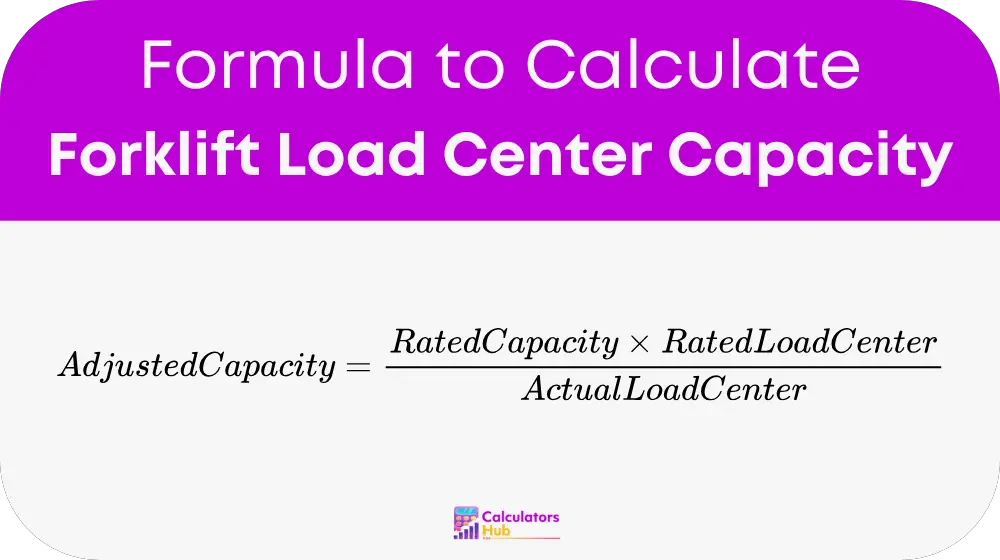A Forklift Load Center Capacity Calculator is a critical safety tool that determines the actual safe lifting capacity of a forklift based on the position of the load. A forklift's stated capacity, found on its data plate, is only valid at a specific, standardized "load center." If a load is longer, bulkier, or irregularly shaped, its center of gravity shifts further away from the forklift's mast. This calculator uses a fundamental principle of levers and moments to calculate how much this shift reduces the forklift's maximum safe lifting weight. Consequently, operators and warehouse managers must use this calculation to prevent dangerous overload situations that could lead to tipping, loss of load, and serious accidents. It is a vital step in ensuring material handling safety.
formula of Forklift Load Center Capacity Calculator
The safe lifting capacity of a forklift changes based on the load's center of gravity. You can calculate the adjusted safe capacity using the following formula.

Here is a breakdown of the formula's components:
- Adjusted Capacity = The maximum safe lifting weight at the actual position of your load's center of gravity (in lbs or kg).
- Rated Capacity = The maximum lifting weight specified by the manufacturer, found on the forklift's data plate.
- Rated Load Center = The standard horizontal distance from the vertical face of the forks where the rated capacity is valid (typically 24 inches or 600 mm).
- Actual Load Center = The true horizontal distance from the face of the forks to the center of gravity of the load you are lifting (in inches or mm).
Forklift Capacity Derating by Load Center
This table illustrates how a forklift's safe lifting capacity decreases as the load center moves further away from the mast. The example uses a standard forklift with a rated capacity of 5,000 lbs at a 24-inch load center.
| Actual Load Center (inches) | Calculation | Adjusted Safe Capacity (lbs) |
| 24 (Rated) | (5000 × 24) / 24 | 5,000 |
| 30 | (5000 × 24) / 30 | 4,000 |
| 36 | (5000 × 24) / 36 | 3,333 |
| 48 | (5000 × 24) / 48 | 2,500 |
| 60 | (5000 × 24) / 60 | 2,000 |
Example of Forklift Load Center Capacity Calculator
Let's look at a practical scenario where an operator needs to lift a long crate.
First, the operator checks the forklift's data plate to find its rated capacity.
Rated Capacity: 6,000 lbs
Rated Load Center: 24 inches
Next, the operator measures the crate to determine the actual load center. The crate is 72 inches long. For a uniform load, the center of gravity is at half its length.
Actual Load Center = 72 inches / 2 = 36 inches
Now, the operator uses the formula to calculate the adjusted safe capacity for this specific lift.
Adjusted Capacity = (Rated Capacity × Rated Load Center) / Actual Load Center
Adjusted Capacity = (6,000 lbs × 24 inches) / 36 inches = 4,000 lbs
Therefore, even though the forklift is rated for 6,000 lbs, the maximum safe weight for this 72-inch long crate is only 4,000 lbs. The operator must ensure the crate's actual weight does not exceed this limit.
Most Common FAQs
A forklift operates on the same principle as a seesaw. The front wheels act as the fulcrum. The load pushes down on one side, and the forklift's counterweight pushes down on the other. Moving the load's center of gravity further out increases its leverage, making it "feel" heavier and more likely to tip the forklift forward.
This critical information is always listed on the forklift's data plate, which is a metal plate typically located in the operator's view, near the dashboard. Always refer to the data plate before performing any lift, as it is the official source of information from the manufacturer.
Yes, absolutely. Any attachment, such as a clamp, rotator, or boom, adds weight and moves the effective load center further away from the mast. The data plate on the attachment itself should specify the new, combined capacity of the forklift and attachment together. You must use this updated capacity for all calculations.